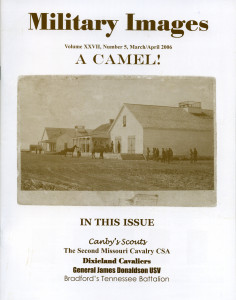The complete issue
Vol. XXVII, No. 5
(40 pages)
Print edition: Visit our store to check availability
Digital edition: Visit JSTOR.org to purchase
Subscribe to MI
Explore the MI Archives: Browse | Advanced search | Tutorial
Inside
Cover image
A carte de visite courtesy of the Drum Barracks Garrison Society pictures a camel, the only known image of the pack animal in the U.S. army during the 1850s and 1860s.
Table of Contents (p. 1)
Editor’s Desk and Mail Call (p. 2)
The editor describes how he found the cover carte de visite on eBay in 2005 and was pleased to find that the winning bidder was MI contributor Mile Sorenson. He goes on to note the top-notch images in this issue and praise senior editors Mike McAfee and John Sickles. A single letter to the editor adds details about the flag of Horse Battery M, 2nd U.S. Artillery. The unit was featured in the last Uniforms and History column.
Passing in Review (pp. 3-4)
Three books are recommended: For Dixie Land I’ll Take My Stand! Somebody’s Darling: Images of Mississippi (Chickasaw Bayou Press) by H. Grady Howell Jr.; Antietam: Then & Now (Thomas Publications) by Garry Adelman and Where Custer Fell: Photographs of the Little Bighorn Battlefield Then and Now (University of Oklahoma Press) by Brian C. Pohanka and Sandy Barnard.
Stoneman’s Raid to Macon by John Sickles (pp. 5-15)
The author notes that Stoneman had hoped to destroy railroads and free prisoners of war, but in the end many found themselves in prison camps. A history of the raid follows, illustrated by identified images of Nicholas Barkes, Peter Reising, William R. Sanford and Newton Smith of the 14th Illinois Cavalry, George S. Amrick, Will Angel, Thomas Butler, Edward N. Elliott, Benjamin Farley, Russell P. Finney, Tillman H. Fisher, Erastus Holmes, William Jefferis, David W. Patty, Charles Rugg, J. Albert Smith, Melville H. Soper and George Whitenack of the 5th Indiana Cavalry and James Biddle and Nathaniel Craigmile of the 6th Indiana Cavalry. Also included is a post-war image of Joseph Clouse of the 5th Indiana Cavalry.
A Most Curious Corps by Michael K. Sorenson (pp. 16-17)
The brief but unique history of the U.S. Camel Corps in the American West is detailed, and it is illustrated by a detail of the cover image and a bell purportedly used on camels in the army service during the 1850s and 1860s.
The Second Missouri Cavalry C.S.A. by John Sickles (pp. 18-20)
The author provides a brief history of the Confederate regiment, which is illustrated by portraits of Col. Robert “Black Bob” McCulloch, Lt. Col. Robert A. “Red Bob” McCulloch, David C. Boggs and two unidentified members of the regiment.
Dixieland Cavaliers by John Sickles (pp. 21-23)
Images and details are provided about the life and service of the following Confederate soldiers: 2nd Lt. B.A. Powell of the 3rd Tennessee Cavalry, Pvt. W.B. Middleton of the 3rd Kentucky Mounted Infantry, Pvt. John Pierson of the 7th Alabama Cavalry and Pvt. M. Bolen of the 64th North Carolina Infantry.
Canby’s Special Scouts by Michael J. Martin (pp. 24-27)
The author explains the background of these mounted citizen scouts authorized by Maj. Gen. E.R.S. Canby. Pictured is the officer who organized the scouts, 1st Lt. Isaac N. Earl of the 4th Wisconsin Cavalry. Two wartime images of scouts Nelson Porter and Warren Knowles, and a postwar photograph believed to be Charles Baker, are also incuded.
Brevet major General James Lowry Donaldson, “The Forgotten Quartermaster” by Henry A. Pomerantz (pp. 28-31)
Described as one of the many “invisible person” who toiled behind the lines as quartermasters, Donaldson (1814-1885) became something of a right-hand man to Quartermaster Gen. Montgomery C. Meigs. Nine portraits of Donaldson taken at various times during the war illustrate the story.
Uniforms & History by Michael J. McAfee (pp. 32-33)
In the “Bradford’s Battalion, Tennessee (Union) Cavalry,” McAfee provides a short history and statistics about this regiment, which faced Gen. Nathan Bedford Forrest’s cavalry at Fort Pillow on April 12, 1864. It is illustrated with a carte de visite of Lt. Mack J. Leaming, who survived the fighting, which included the murder of numerous African American soldiers.
The Confederate Soldier (p. 34)
A sixth-plate ambrotype of a well-armed first lieutenant wearing the number 7 on his lapel is part of the Brian Boeve collection. The image is inscribed “Elzi Benson 3 August 1861.”
Stragglers (pp. 35-38)
A total of 12 portraits include Lt. John J. Fray and Pvt. William A. Brawner of the 43rd Partisan Battalion, Mosby’s Cavalry. The men were photographed in civilian clothing about 1861. Also included is Cpl. Charles Rude of the 100th Indiana Infantry and Maj. James E. Doran of the 24th New York Cavalry and his son.
Sutler’s Row (p. 39)
The Last Shot (p. 40)
A sixth-plate tintype from the Roy Mantle collection is an unidentified federal first sergeant fully equipped for the war.



































